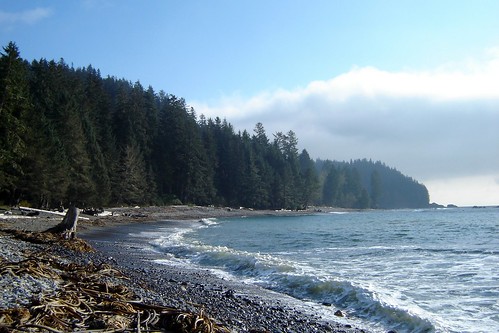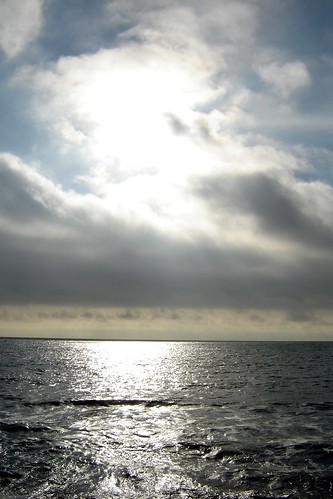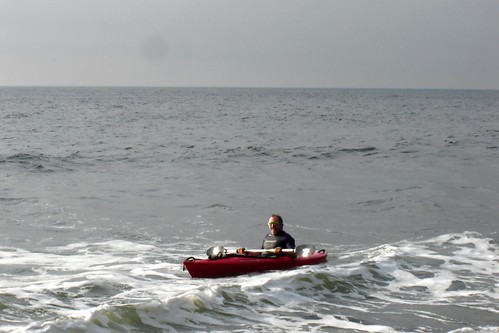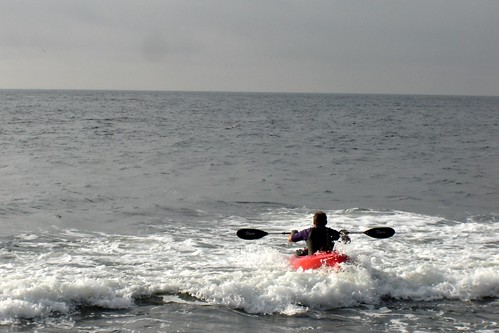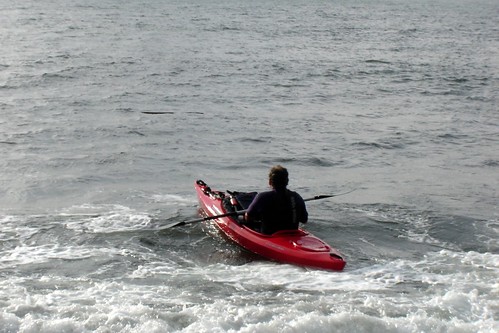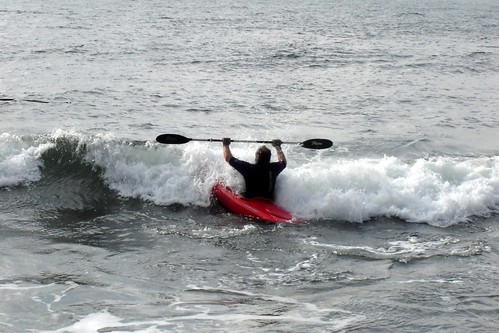But in late afternoon, the sun can disappear as the clouds roll in, and the wind can whip the calm surface into a frothy chop. And it was in these conditions that a friend who wished to remain anonymous (for reasons that will become clear) and I found ourselves as we arrived for our first kayak lesson.
We have some previous experience kayaking. We had bought some small roto-molded kayaks earlier in the summer and we had made splashing about a regular event. We’d gone to many of the local lakes, and had gone out on the ocean a few times, always being careful not to go on stormy days, and trying not to over-estimate our abilities. Kayaking on a lake is like playing in a bathtub, but on the ocean, it’s a whole different feeling. The ocean is constantly moving and shifting underneath you, wakes bounce you, and currents pull at you.
The sights you can see! Eagles, otters, seals, sea lions, fish, crabs, sea stars… even an old paddle wheeler! (or a new faux paddle wheeler, since the wheel, although it spun, didn’t seem to actually touch the water).
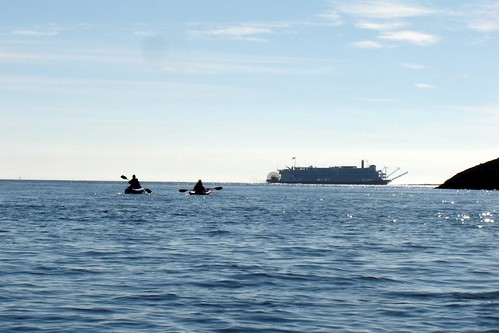
It’s fun, but dangerous even you don’t know what you’re doing and that described my friend who will remain unnamed (his initials are E.B. Klassen) and myself, so we decided we’d better take some lessons and learn what we’ve been doing wrong all this time.
We arrived at Elk Lake and immediately noticed how rough the water was. (Indeed, the wind was to plague us for the entire session, as it kept blowing us ashore). A local kayak store was offering lessons, and they supplied the instructor, boats and accessories. We had our own wetsuits on; we figured we were going to get wet. But life jackets were another matter, as the tour company didn’t bring enough large ones, and after much swapping around, I ended up with an ill-fitting medium jacket that I only did up when we did our wet exits.
There were only three of us in our course: my anonymous friend (the aforementioned E.B.Klassen), an 85 year-old woman named Marion, and myself. We selected our boats: I ended up with a 12 ½ foot Necky, and my nameless friend (E.B.Klassen, or Bernie to his friends and some family members) took a 14 ½ foot Carolina. Our instructor Brian was outfitted in top gear. In fact, he was trying his brand new $1,000 dry suit for the first time. Bernie and I had seen it in a store only a few days earlier. It was still covered with our drool stains.
Once we were outfitted and in the water, Brian demonstrated a few strokes for us. Marion was off like a rocket and poor Brian had to keep catching her and bringing her back close to shore.
The boat I was in was longer but narrower than my own boat and took a little getting used to. For a while it felt like I was always going to go over, but I eventually got used to the boat and the feeling passed.
Bernie had been in a Carolina previously and quickly adapted. Soon he was trying more sophisticated stroking techniques such as bracing and edging. Marion was doing well, too, but struggling against the choppy waves.
After covering the material in the lesson, which was the basic kayak strokes, Brian decided to give Bernie and I some bonus lessons and have us practice some wet exits. Marion declined to participate in this portion – she wasn’t dressed to be dunked.
Brian beached his boat and walked out to Bernie and I in the lake. And we got dunked.
Basically, a wet exit is getting out of your kayak when you capsize. When you tip, the key is not to panic and remember, that it’s okay, you’re just in water. Keep your head, don’t panic. Getting out of the kayak is really fairly simple. You grab the handle on the front of your skirt (your skirt is the neoprene cover that seals you into the cockpit and makes it watertight). You pull the handle and the skirt comes off easily. Air rushes out of the cockpit and pushes you out, and your personal floatation device brings you up to the surface.
It really is pretty easy, once you get over the fear of being stuck in the tight-fitting cockpit of a kayak that’s turned upside down and there’s water going up your nose. After a couple of tries, though, it becomes doable. Bernie took his glasses off and prepared for his own dunking.
Next, Brian decided to offer more bonus instruction and show us how to do a two-person rescue. Let’s say you’re paddling with a buddy (as you should be at all times) and buddy ends up in the drink. How do you get him out of the cold water and into his boat? (And in the ocean, you’ve got to be quick. The cold water will quickly rob you of your body heat. And if you don’t have proper gear on, like a wet suit or dry suit, you’re in real trouble if you stay in the water for long.)
In our first practice scenario, I played the rescuer while Mr. Anonymous (that’s Bernie) was the hapless victim. So Bernie dunked himself.
One thing to remember when getting dunked is to try to keep track of your paddle. It’s all fine and dandy to get yourself back in your boat, but if you lose your paddle, you’re not going anywhere. We have paddle leashes on our personal boats for just such an emergency, but we were out of luck with these boats, so it was important to keep a hand on our paddles.
Bernie (our victim) capsized, exited his boat, and surfaced still clutching his oar. So far so, good. Next the hero (that would be me) maneuvered his kayak across the bow of the victim’s boat, in effect crossing the “T” while Bernie hung on at the stern of his boat. At this point, we righted his boat. Now both boats were upright, with his perpendicular to mine at about my cockpit. Before we get Bernie into his boat, we needed to get the water out, so we lifted/pulled/pushed Bernie’s boat onto mine. (This is why the first thing we did was right Bernie’s boat. With the kayak upright, it’s much easier to raise his boat onto mine because of the shape of the hull.)
With his kayak sitting on mine, we tipped his over, drained it of water, then righted it again, and lowered it back into the water. Next we maneuvered the kayaks until they were beside each other, but bow to stern. I leaned over and grabbed hold of his boat around the cockpit, and Bernie climbed onto his stomach on the back of his boat. He swiveled so his feet were in the cockpit, and he scooched down the deck of his kayak on his stomach into the cockpit, turning around so that ended up facing the correct way.
It’s not easy. You’re fighting the wave action, and the boats are slippery. As the rescuer you have to grip tight all the way through the process. Your weight is shifting constantly as the victim struggles to get in and the waves lap at both kayaks.
But, like a wet exit, it’s doable. And if you’re going to be on the water you need to be able to do this. You never know when it may come in handy.
We traded places and I dunked myself, and now with Bernie being the rescuer, I was able to return whole but wet into my boat. Brian our instructor congratulated us and said he was walking back to shore and that we should go for a little paddle to warm up after our dunkings, then return to shore ourselves. Our lesson was done.
Bernie put his glasses back on and he and I headed out for our quick paddle. The water was still choppy, and now it was about 6:30 in the evening and the light was going. We shouldn’t stay out on the lake much longer.
Then behind me, I heard Bernie shout, “Oh shit, oh shit!” Then there was a splash.
Bernie was under water.
I turned around and saw an overturned kayak and no Bernie. He broke the surface, shouting something. I called, “Are you alright?” He seemed to be fine, but he was still shouting something that I couldn’t make out.
Then I realized, “Oh yeah, I have to rescue him!”
I turned my kayak around and quickly paddled over. When I arrived, crossing the “T”, he was laughing. “I can’t believe it! Forty hours in the boat this summer and I tip while I’m having my first lesson!”
We struggled to lift Bernie’s kayak onto mine. I realized later that we had forgotten to right his boat before trying to raise it. Still, we got it up and emptied of water. Then we flipped it over and I moved my kayak beside his.
Bernie was still laughing. Something was putting him in a great mood, apart from the obvious irony of capsizing two minutes after learning how to rescue someone from such a predicament.
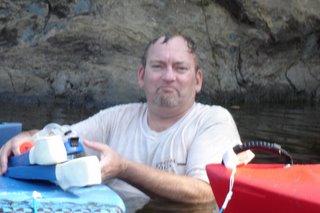
Finally, after a few moments of struggling, he was back in his kayak and he was still laughing.
“My glasses,” he said. “I was underwater and I saw my glasses floating away from me. I reached out and was just able to grab them. That’s what I was shouting about when I surfaced. I couldn’t believe I still had my glasses!”
That’s what I heard when he went over! A couple of cries of “Oh shit,” a splash followed by a couple of blub blubs, then Bernie breaking the surface with his glasses in his fist, shouting, “Woo hoo!”
We couldn’t stop laughing. Adrenaline and near-death experiences can do that to you. We calmed down and slowly paddled back to the beach. Brian shrugged his shoulders, and said, “I guess you passed!”




